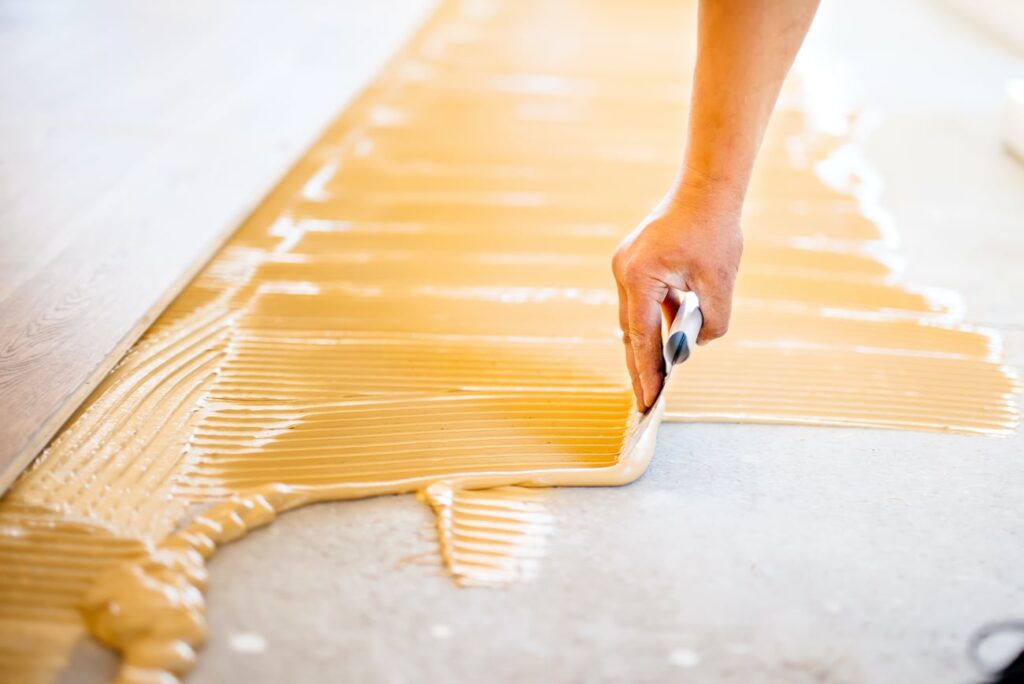If you come to a house and see how gorgeous the floor is, big chances that you won’t be even thinking about the complicated layers of the floor, including flooring underlayment or such thing alike.
The floor has never been the simplest part of home improvement work. What you see on the surface isn’t exactly the same to what you see underneath.
So, before you decide on a flooring type, it is best to understand the type as well as the complete structure of the floor.
Flooring Underlayment Basic
As it was mentioned before, the flooring underlaymentis a part of the many layered components.
Each component has its own function and importance that contributes to the way the floor functions and holds up against beat and wear.
If you manage the layers properly, you can be sure that it will stay durable and solid for so many years. And underlayment is pretty crucial.
Some floors may need it, while some may not. Again, it all depends to the type of floor you want to install.
Floor’s Anatomy
When we are talking about the floor’s anatomy, we are talking about many layers that make up the floor’s surface and its effect.
In general, there are 4 major layers for the construction of the floor. From the bottom to the top, the layers are:
- Joists
They are the lateral wooden frame that is placed on the beams and foundation walls.
Joists are important as they are responsible for the framing system’s structural support.
Joists are generally made from 2 x 10 or even 2 x 12 lumber. It is also possible to use engineered microlam members for the joists.
- Subfloor
This is basically the plywood layer where underlayment (and also floor covering) will be installed.
These panels of plywood are important because they contribute rigidity and strength to the entire construction (of the floor).
You will have to attach the subfloor to the joists. Normally, the plywood is around 19/32 inch to around 1 1/8 inch of thickness.
- Floor covering
This is the flooring surface within the visible and finished form. If you see ceramic tile, carpet, vinyl, or planks, they are the final outcome.
Whether they are beautiful, elegant, ugly, or artistic, this is the part visible to the eyes of the beholder and the part that you walk on.
- Underlayment
The flooring underlayment is located right under the floor covering. The material is generally quite thin set between ¼ inch and ½ inch in thickness.
The function is to provide a flat and smooth surface for the floor covering.
Depending on the types of the floor covering, you should also choose different kinds of materials for the underlayment.
Feel free to use hardboard, cement board, and plywood for the underlayment. The standard one is the (thin) foam padding.
If you don’t know what kind of underlayment to install on your floor, it’s better to consult a professional installer.
Read Also: Basement Flooring Options Different Types for the House
The Purpose and Function
Naturally, there are some purposes why homeowners would install the underlayment on the floor.
Underlayment is the material resting between the subfloor and the floor covering and it is generally quite thin.
Whereas the subfloor is an important part of structure and framework of the house, the underlayment is crucial to deliver a smooth, flawless, and flat surface.
In this way, floor installation can go easily to create attractive outcome.
However, there are also other functions of the flooring underlayment, such as to absorb the noise, especially the footsteps’ sounds.
It can also be used to act as a barrier for moisture so any spill from the surface won’t seep into the inner part.
The underlayment can also soften the flooring underfoot’s feeling so you won’t have to deal with loud and noisy click of the heels whenever you are walking.
Basically, the main purpose of the underlayment is:
- To improve structural ability
If you use hard underlayment, the floor has a better sense of stability. This is quite important when you have old house.
In old houses, the subfloor is generally constructed from boards instead of plywood sheets.
- To create smooth surface
With the underlayment, you basically prepare a smoother basic for the floor covering. This is quite important for mostly structural shape or role
- To improve adhesion
Take an example from a cement board. When you use it as an underlayment, you basically provide a pristine surface so that ceramic tiles can be attached to the surface.
You see, tiles won’t stick well to the subfloor when directly applied. That’s why you need the underlayment, so the tiles won’t contract and expand.
Do You Need Flooring Underlayment?
The decision to use flooring underlayment or not depends on the condition of the subfloor and the type of the floor, really.
If your subfloor is still in a perfect condition, you may not need any underlayment or whatsoever.
Instead of using underlayment, you may only need to spread rosin paper layer on the top of the subfloor and the floor covering can be attached directly on it.
If the subfloor is in a totally bad condition, you may need to remove the old one and have a new one installed.
In most modern remodeling projects, it is possible for contractors to check the subfloor’s condition first.
For them, subfloor is more important than the underlayment. If the subfloor is still in pristine condition, then the underlayment may not be needed.
If the subfloor is completely bad, they prefer replacing it with a new one so they can directly attach the new floor to the subfloor.
After all, it is quite common that homeowners may use the previous floor as the flooring underlayment.
Let’s say that you already have a sheet vinyl. But you are thinking about having laminate floor as your new floor.
You can directly attach the laminate floor directly over the vinyl sheet. It is also common that carpets are installed over the hard floor without any underlayment or whatsoever.
If you want to get the best result, it’s better to consult a professional service. They can help you determine whether you need the underlayment or not.
Rigid Types of Flooring Underlayment
Rigid underlayments are perfect for most flooring types because it promotes sturdiness and solidity.
Here are some types of the rigid underlayment types:
- Cement board
There is several cement board sheets used for mortared flooring, which is common for ceramic tile, porcelain floor, or stone floor.
It may come in the form of fibrous cement board sheet (like Durock) or cement board sheets (like Wonderboard).
If the floor doesn’t require any mortar, then you can’t use the cement board. The sheet is relatively easy to cut with smooth appearance. It is also resistant to mold.
- Underlayment panels
They are interlocking system coming in tiles sizing in 2 x 2 foot. The panels can be quite costly, but it helps with fast installation. It is great as a moisture barrier.
This type of underlayment is suitable if you install laminate flooring or carpets on the concrete slab. The panels help to lift the floor a bit off the concrete
- Plywood
The plywood sheet generally comes in 4 x 8 foot, and it is cut to the preferred size. It is known as A/C grade referring to the A side that has smooth face (for the top surface) and the C side for the rough side (the bottom side).
The general preferred sheet is the one with ¼ inch thickness up to ½ inch. This underlayment is perfect for engineered wood, laminate, and hardwood flooring.
You can either choose the tongue-and-groove flooring underlayment sheets or the straight edge one.
- OSB
It is short for Orient-Strand Board, which is generally used as the alternative to plywood. In most cases, homeowner may choose either plywood or OSB.
Soft Types of Flooring Underlayment
These days, homeowners may choose soft underlayments, like cork sheets or foam sheets for the underlayment.
These soft underlayments are known as floating underlayment because they aren’t connected or attached to the existing subfloor.
These soft underlayments have two functions. They can create smooth surface, hiding out the imperfections like small knot holes or (protruding) screw heads.
Although they aren’t advised for rigid underlayment replacement, they are pretty good for covering old floor still in good condition.
For instance, you already have an existing ceramic tile or wood floor. But you want to install laminate flooring. You use the cork or foam layer for the underlayment.
So, it’s like having two types of underlayment the rigid and the soft one. The soft one is laid on top of the rigid one.
When such construction is done, the soft underlayment can act as a cushion for the top floor covering.
Laminate flooring usually has its hollow feel and sound, but with soft underlayment, it won’t be that way.
Read Also: Best Flooring for Kids Bedroom to Consider
Flooring Underlayment Handy Tips
You may want to keep the underlayment quite thin. Thicker one will create issues because they can lead to more serious issues concerning different rooms and different materials. With significant thickness, transitions can create issues.
You don’t want the level in one room to be higher substantially than the nearby rooms. And if you have too thick underlayment, it can be a problem in rooms having low ceiling.
You have a shortened and narrow space and overall height. In the end, the decision to have an underlayment basically depends on you and the types of flooring you choose.
Be sure to get a complete research about flooring underlayment and whether you need one.





